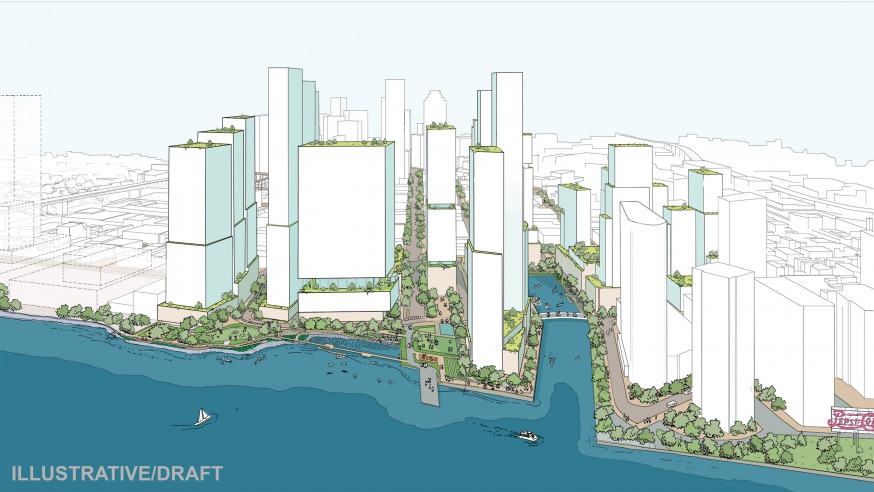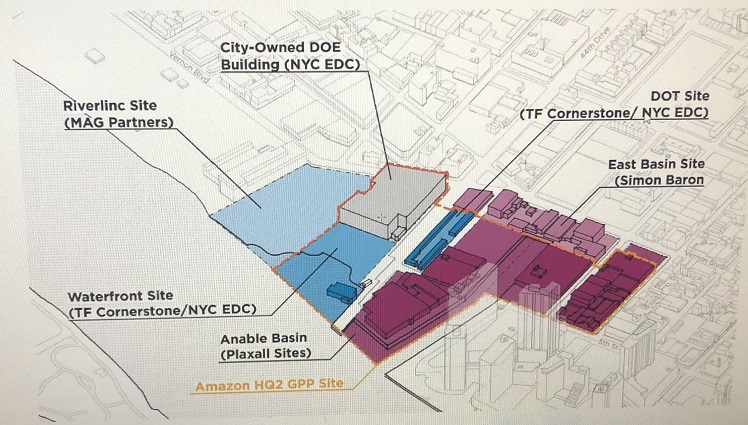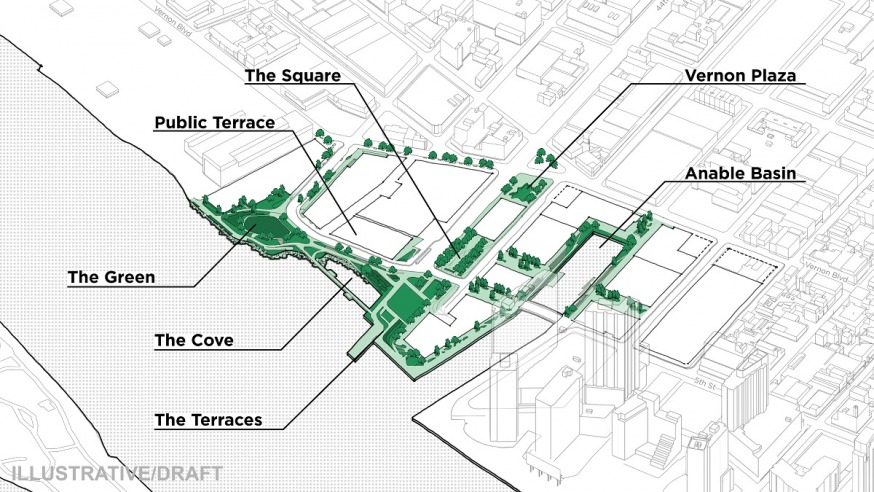
A rendering of Hunters Point including the development plan (YourLIC)
May 21, 2020 By Christian Murray
A group of developers looking to build on a 28-acre section of land surrounding Anable Basin provided an overview of their plans at a Community Board 2 Land Use Meeting Wednesday night.
The developers announced that they are looking to build 10-to-12 million square feet of space on the 28-acre area with buildings that range in height from 400 to 700 square feet, the equivalent of 30 to 60 story structures.
The plan would focus heavily on commercial space, and the project would be developed over a 10 to 15 year period. The developers aim to get the property rezoned next year.
The plan includes 7 acres of open space, space for three schools and ½ million square feet for arts and cultural space and similar uses. The plan would also include a pedestrian/bicyclist bridge over Anable Basin that would connect 5th Street on both sides of the water.
The developers said that about 50 percent of the 10-12 million square feet would be for commercial use. The proposal would also include mixed-income housing, although the number of units was not disclosed at the meeting.
The plan–presented by a development team consisting of TF Cornerstone, Plaxall, Simon Baron Development and MAG Partners—incorporates the sites where Amazon HQ2 was slated to be built as well as some adjacent parcels.
The developers—with the exception of TF Cornerstone—each own a portion of the 28 acre area. TF Cornerstone is looking to develop two city-owned lots on 44th Drive, which are part of the 28-acre area.

A map of the 28-acre area (Rendering: YourLIC)
The group came together last year at the request of the city council, which called for the developers to come up with one unified rezoning plan for the area as opposed to each having a separate concept for their own property.
The developers formed YourLIC and have hosted four workshops since November to solicit feedback from residents covering topics such as economic empowerment to open space. A fifth workshop was postponed due to COVID-19.
“We want to create a true mixed-use district with all the community resources needed to make it a place to live, work, play and thrive,” said Paula Kirby, managing director of Plaxall, whose family has operated a plastics factory and owned property in Long Island City for 70 years.
The developers said the project provides Queens with the opportunity to develop an economic engine at a time when New York City—and the borough especially—has taken a financial hit. They said it would generate a significant number of high-paying jobs.
The development team said that the scale and height of their buildings would also be in context with other Long Island City districts–such as Court Square and Hunters Point South.
“We believe this is appropriate for this location,” said Eleanora Bershadskaya, a Senior Associate at TF Cornerstone.
TF Cornerstone, she said, is developing parcel C at Hunters Point South, with one of its two towers reaching 550 feet.
Furthermore, the properties in the Court Square section of Long Island City are of a similar size. For instance, One Court Square—also known as the Citigroup Building–is 50 stories tall and about 670 feet tall. The Skyline Tower, which is going up at 23-15 44th Dr., will be 778 feet high and 68 stories.
The developers were asked about the scale and density of the plans given the pandemic. They said that they are planning for the long term and that there will be demand.
“We think density makes New York City great and we remain committed to that,” said Ashley Cotton, with MAG Partners. “We think immigrants, young people, professionals and college grads will continue to come here.”
The group went into detail about the open space, noting that it would provide a connection to Hunters Point South and sets the stage for a corridor that could eventually go to Queensbridge.
The plans call for a junior soccer field, a tot lot and a track at the northern section. Then farther south, provisions are made for a plaza, esplanade, kayak launch and more.

A map of the proposed open space (YourLIC)
Kenny Greenberg, a member of the Land Use Committee, asked why the city-owned sites on 44th Drive were not being exclusively used for public use. He noted that community activists and elected officials—such as Congresswoman Carolyn Maloney—have called for the city-owned parcels to be used for a public purpose.
Bershadskaya, with TF Cornerstone, said that the developer has taken into consideration what has been said and changes have been made.
The initial plans for the parcels– that were put out as an RFP by the Economic Development Corp– called for 1,000 residential units along with commercial space and various amenities.
The sites, Bershadskaya said, will no longer be used for residential purposes. The sites will be for commercial use only and will include public space and a public school.
“We are committed to public amenities,” she said. “This feedback hasn’t fallen on deaf ears.”

Anable Basin (YourLIC)
One Comment







Record construction in Long Island City has not been accompanied by any significant increase in transit capacity to accommodate thousands of new residents. The same is true for thousands more who commute from other neighborhoods to jobs in LIC.
There are opportunities to increase capacity and service by running trains more frequently mid-day, evenings, overnight and weekends on the #7 line. Until the 1980’s, there was Manhattan bound express service till 12:30 PM. Flushing bound express service began after 1 PM. There has been no express service between 10 AM and 3 PM due to periodic ongoing track, power, signal, and routine maintenance projects for decades.
There are opportunities to increase capacity and service by running trains more frequently mid-day, evenings, overnight and weekends for both the #7 and G subway lines. There is always equipment used primarily for rush hour peak service that is available to provide additional service during off peak hours. It is a question of finding millions of dollars more to cover operating costs for additional service.
Why not extend 8 of 14 Long Island Rail Road trains currently terminating at Hunters Point during AM rush hour to LIC? Turn trains around to provide reverse commuter service. In the PM rush hour, start 7 of 12 trains from LIC instead of Hunters Point. Establish new off peak, mid day and evening service between LIC and Jamaica.
New ferry services will be able to accommodate only so many riders. In many cases, a majority of new residents and employees will need the subway rather than the ferry to access employment, educational, medical and entertainment opportunities in Manhattan and other boroughs. The continued economic success of new business coming to LIC is dependent upon not only additional transportation capacity, but capital improvements to sewer, water, electrical and utility assets as well. Municipal fire, police and sanitation services will also have to be expanded. What is the cost and who will pay for all these additional capital improvements and services?
(Larry Penner — transportation advocate, historian and writer who previously worked 31 years for the Federal Transit Administration Region 2 NY Office.)